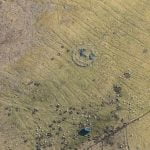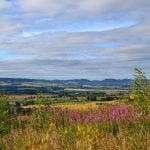The Cateran Trail , one of Scotland’s great long-distance footpaths, runs across much of the Cateran Ecomuseum area.

Old Drove Road, Alyth, photo Clare Cooper
It incorporates many historical paths, trackways, and old military roads into its 64 mile circular route. Some sections follow paths once used by Drovers and Caterans which were the only terrestrial ways through Glenshee and Strathardle before the military roads came in the AD 1700s. Cateran derives from the Gaelic word ceatharn meaning a lightly armed warrior. References first appear in historical records of the late AD 1300s with reports of livestock being raided by armed bands of Caterans. These were harsh times in the highland glens of Strathardle, Glenshee and Glen Isla where a wetter, colder climate, plague, and the recent wars with England made it increasingly difficult to make a living from the marginal farmland. Livestock were a high value commodity and raiding them offered a viable solution to financial hardship. The other alternative to raiding cattle was to drive large herds of them to market and sell them.
The Scottish cattle droving trade emerged out of this same poor climate where long winters and infertile soils meant a shortage of stored feed to sustain the large numbers of cattle produced through the feudal open common grazing system.
The solution was for local men to visit surrounding farms, negotiate a price for small numbers of cattle and gather them together into large herds of 100-2,000 strong. The Drovers would head south and east, trading livestock at markets where demand and profits were higher. Through trade between Drovers, cattle from the Highlands could reach as far as York and London. The drove roads were long and the journey full of hazards, from fording fast flowing rivers to the threat of Cateran raids. In the middle of the 18th Century, Kirkmichael’s Michaelmas Fair was a major cattle market and drove roads connecting the village to Spittal of Glenshee and Ballinluig can still be walked today.

